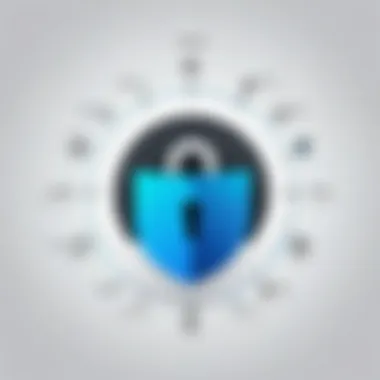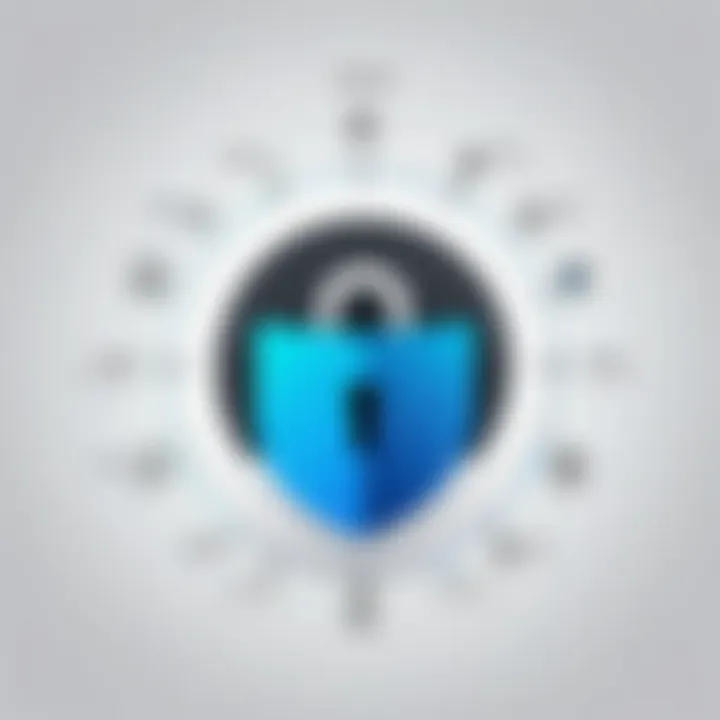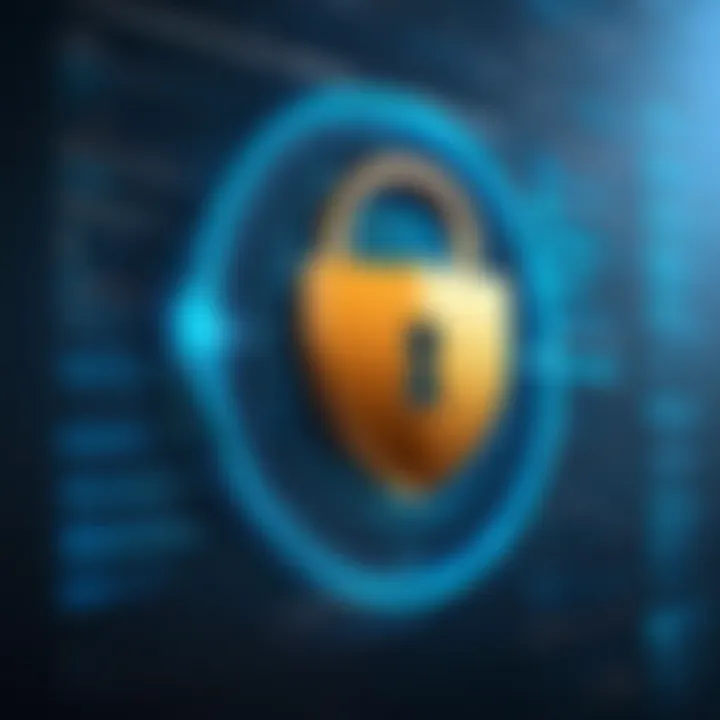Assessing Bitwarden's Security Features and Protocols


Intro
As the digital landscape expands, the importance of cybersecurity has never been more pronounced. Password managers like Bitwarden play a crucial role in safeguarding sensitive information. But how secure is Bitwarden? This article seeks to uncover the security features of Bitwarden, analyze how it handles data, and explore potential vulnerabilities. We will also compare Bitwarden with its competitors, keeping in mind emerging cyber threats and best practices.
Cybersecurity Threats and Trends
In today's interconnected world, cyber threats are increasingly sophisticated. Some notable threats include phishing, ransomware, and data breaches. These threats target individuals and businesses alike, exploiting weaknesses in systems and human behavior. For example, a successful phishing attack can lead to unauthorized access to user accounts, resulting in severe consequences.
Emerging trends in cyber attacks are troubling. Attackers are using advanced tactics like artificial intelligence to automate their efforts. This makes it more challenging to defend against potential intrusions. Moreover, ransomware attacks continue to rise, with criminals demanding large sums of money to restore access to encrypted data.
The impact of these threats is profound. Individuals may face identity theft, while businesses risk losing valuable data and customer trust. As these threats continue to evolve, understanding their implications becomes crucial for effective security practices.
Best Practices for Cybersecurity
To combat these threats, strong password management is essential. Users must create complex passwords that resist brute-force attacks. Implementing multi-factor authentication adds another layer of protection, significantly reducing the risk of unauthorized access.
Regular software updates and security patches should not be overlooked. Developers frequently release updates to protect against newly discovered vulnerabilities. Keeping software up to date reduces exposure to these risks.
Secure online browsing habits and vigilant email practices also enhance security. Users should avoid clicking on suspicious links or downloading unknown attachments, as these can serve as entry points for attacks.
Privacy and Data Protection
Data encryption plays a significant role in ensuring privacy. It converts information into a format that unauthorized users cannot access easily. Therefore, platforms like Bitwarden utilize encryption for secure password storage and management.
However, risks remain when sharing personal information online. Users must be aware of the data they expose in social media and other platforms. It's vital to limit personal information to what is absolutely necessary.
Strategies to safeguard sensitive data involve retaining minimal information online and using tools like secure passwords and encryption. Regular audits of data exposure can help identify areas for improvement.
Security Technologies and Tools
Key cybersecurity tools and software enhance protection against threats. Using well-established antivirus programs helps in detecting and neutralizing potential malware before it can cause damage. Firewalls also complement these efforts by controlling incoming and outgoing network traffic based on predetermined security rules.
Employing Virtual Private Networks (VPNs) can further secure data transmission. VPNs encrypt internet traffic, which makes it harder for malicious actors to intercept communications.
Cybersecurity Awareness and Education
Raising awareness is fundamental to combating cyber threats. Educating individuals on recognizing phishing attempts is critical, as many attacks exploit human psychology. Providing training on cybersecurity basics empowers users to protect themselves effectively.
Promoting a culture of cybersecurity awareness is vital in the digital age. Organizations should invest in ongoing training for their teams. Resources such as online courses, reputable blogs, and forums can provide valuable information.
"Cybersecurity is not just a technology issue; it is inherently a human issue."
Understanding Bitwarden
The security of password management tools like Bitwarden is crucial for both individuals and organizations looking to protect their sensitive information. In a digital landscape where data breaches and cyber threats are commonplace, understanding Bitwarden is not just beneficial but essential. This section delves into the importance of grasping Bitwarden’s functionalities, its implications for security practices, and how it serves as a reliable solution for managing passwords.
Being familiar with Bitwarden aids in realizing its role as a secure vault for storing sensitive data. By utilizing an open-source framework, it allows users to access and manage their passwords with transparency and trust. Furthermore, understanding its security features empowers users to leverage those elements effectively.
Key considerations include Bitwarden's encryption protocols, zero-knowledge architecture, and user data handling practices. These factors are fundamental when assessing whether it meets the requirements for safeguarding sensitive information. This knowledge not only helps users make informed decisions but also enhances their overall digital hygiene by encouraging better password management strategies.
Overview of Bitwarden
Bitwarden is an open-source password manager that provides secure storage and management of passwords and other sensitive data. Founded in 2016, it has since gained recognition for its robust security features and user-friendly interface. Bitwarden allows users to store an array of information, including passwords, secure notes, and credit card details, all accessible across multiple devices.
Its open-source nature is a significant advantage, as it allows security experts to audit its code for vulnerabilities. The platform offers various tools for browsing, sharing credentials securely, and integrating with common browsers like Chrome, Firefox, and Safari.
Bitwarden offers both free and premium subscription options, each catering to different user needs. The free version provides solid basic functionality, while the premium plan includes advanced features such as securely storing file attachments and enhanced two-factor authentication.
Key Features of Bitwarden
Bitwarden encompasses several key features that set it apart from other password managers. Understanding these features is crucial for evaluating its effectiveness and security.
- End-to-End Encryption: Bitwarden employs strong end-to-end encryption to ensure that user data is secured before it leaves the device. This means sensitive information remains unreadable to anyone but the user.
- User-Friendly Interface: It offers an intuitive user interface that facilitates navigation and management of passwords, making it accessible even for less tech-savvy individuals.
- Cross-Platform Availability: Users can access Bitwarden on various platforms, including smartphones, tablets, and desktops. This ensures that passwords are always available when needed.
- Secure Password Sharing: It allows users to share passwords securely with other users, which is particularly helpful for teams or families needing to manage shared accounts.
- Password Health Reports: Bitwarden provides features to assess the strength and security of stored passwords, encouraging users to regularly update weak or compromised passwords.


These features contribute significantly to Bitwarden’s reputation as a reliable and secure password management solution. Understanding them enables users to maximize their security and effectively manage their sensitive information.
Encryption Mechanisms
Understanding the encryption mechanisms of Bitwarden is crucial in evaluating its overall security. Encryption serves as the backbone of data protection, ensuring that sensitive information is not accessible to unauthorized parties. In the context of password management, users entrust these tools with their most private data, emphasizing the necessity of robust encryption protocols.
End-to-End Encryption Explained
End-to-end encryption (E2EE) is a fundamental component of Bitwarden's security architecture. This approach ensures that data is encrypted on the user’s device before being transmitted to the servers and can only be decrypted by the intended recipient.
- User Control: With E2EE, only the user has access to their decryption keys. This means that even Bitwarden cannot access the contents of the user’s vault. It provides a layer of trust and confidence for individuals who may hesitate to store passwords online.
- Data Breach Protection: Since the data is encrypted throughout its journey from the user to the server and vice versa, even if a data breach occurs, the attackers would only gain access to encrypted data, rendered useless without the decryption key.
- Strong Algorithms: Bitwarden employs industry-standard encryption algorithms such as AES (Advanced Encryption Standard) with a 256-bit key length. This level of encryption is recognized as secure against brute-force attacks.
The E2EE model not only serves as a safeguard for sensitive data but also builds user trust, which is essential in a landscape filled with cyber threats.
Zero-Knowledge Architecture
Zero-knowledge architecture complements the encryption methods used by Bitwarden. This principle eliminates the storage of user plaintext data on the company's servers and reinforces privacy.
- No Data Access: In a zero-knowledge setup, Bitwarden does not have access to user credentials or any other sensitive information. All data remains encrypted on the user’s device, only decrypted when accessed by the user.
- User Accountability: This design means that users are fully responsible for their data. If a user forgets their master password, recovery is impossible. While this may seem negative, it reinforces the importance of maintaining strong and memorable passwords.
- Trust and Transparency: Bitwarden’s zero-knowledge approach is an assertion of its commitment to user privacy. This transparency is vital for users, as they seek assurance that their data is not being exploited or accessed without consent.
"In a world of increasing privacy concerns, the zero-knowledge model provides a secure haven for users, allowing them to securely store their information without fear of undue access."
Overall, the combination of end-to-end encryption and zero-knowledge architecture positions Bitwarden as a secure choice in password management. These mechanisms enhance user trust while minimizing the risk of data exposure.
Data Handling Practices
Data handling practices are critical in assessing the security of a password manager like Bitwarden. This section elaborates on how user data is stored, managed, and transferred, highlighting key elements that add layers of security. In an era where data breaches are rampant, understanding how a service handles sensitive information can help users make informed decisions.
User Data Storage
Bitwarden employs a secure method for storing user data. The passwords and sensitive information are encrypted on the user's device before being sent to the server. This means that even if someone gains access to the server, they will see only encrypted data, not plaintext information. This method mitigates the risk of data breaches significantly.
There are some important points to consider regarding user data storage:
- Division of Data: Users' data is segmented, making unauthorized access to all information difficult.
- Encryption Standards: Bitwarden uses AES-256 bit encryption, a strong standard considered industry-leading for securing sensitive information.
- User Control: Users have the ability to set their own master password, which adds an additional layer of control and personalization over their data security.
Storing user data responsibly is a priority. By adopting strong encryption practices, Bitwarden demonstrates its commitment to protecting users’ sensitive information.
Data Transfer Protocols
The protocols used for data transfer are just as important as how data is stored. Using secure channels for data communication is vital to prevent interception by malicious actors. Bitwarden utilizes Transport Layer Security (TLS) protocols to encrypt data during transmission. This ensures that the data exchanged between the user's device and Bitwarden's servers remains confidential and intact.
Key considerations for data transfer protocols include:
- Secure Transmission: All communication happens over HTTPS, which safeguards against man-in-the-middle attacks.
- Data Integrity: TLS not only encrypts data but also validates its integrity. This obscures the data during transit, ensuring it stays unchanged.
- Regular Audits: Bitwarden undergoes regular security audits to ensure that their data handling practices meet current cybersecurity standards.
Account Security Measures
Account security measures play a crucial role in safeguarding sensitive information within a password management tool like Bitwarden. These measures ensure that unauthorized access is minimized and that users have robust defenses against common vulnerabilities. As cyber threats continue to evolve, the importance of implementing strong security protocols cannot be overstated.
The main elements of account security include multi-factor authentication, strong password policies, and features like password generation. These components play a key role in enhancing overall security and protecting user data from potential breaches.
Benefits of Account Security Measures:
- Enhanced Protection: They create barriers that deter unauthorized users.
- User Control: They empower users to manage their security preferences.
- Risk Mitigation: They address common vulnerabilities that arise in digital environments.
In the context of Bitwarden, understanding these measures helps users to make informed decisions about their security practices. Each feature serves a specific purpose, working together to create a comprehensive security framework.
Two-Factor Authentication
Two-Factor Authentication (2FA) is an integral part of Bitwarden's security strategy. By requiring a second form of verification, it significantly enhances account protection. This method ensures that even if a password is compromised, unauthorized access remains unlikely.
When enabling 2FA, users typically select from various methods, which may include a time-based one-time password (TOTP) or a mobile authenticator app. Each option has its unique advantages and limitations, but they all add an additional layer of security.


Key Point: Two-Factor Authentication reduces the risk of password-related breaches significantly.
Considerations:
- Users must maintain access to the chosen second factor.
- Recovery options are essential for regaining access if 2FA devices are lost.
Password Generator Functionality
Bitwarden’s built-in password generator is an essential tool that aids users in creating secure passwords. It generates complex and unique passwords, mitigating the risks associated with weak or reused passwords. Given that many security breaches result from poor password management practices, this feature is invaluable.
Users can customize the generator’s output by choosing parameters such as length, character types, and avoidance of easily recognizable patterns. This flexibility allows for the creation of strong passwords tailored to individual preferences or specific use cases.
Benefits of Using a Password Generator:
- Strength: Generated passwords are usually much stronger than those created manually.
- Convenience: It simplifies the password creation process, often saving time.
- Reduction of Human Error: Automated generation minimizes potential mistakes.
In summary, the combination of Two-Factor Authentication and a robust password generator contributes to Bitwarden's comprehensive security framework. Utilizing these features would provide users with a significant advantage in managing their digital security.
Vulnerability Considerations
Understanding vulnerabilities is critical when assessing any password management tool, including Bitwarden. Recognizing potential weaknesses allows users to make informed decisions and to implement necessary precautions. Vulnerability considerations encompass numerous aspects: common threats, known software flaws, and the overall security landscape. By engaging with this topic, users can better protect their sensitive information.
Common Threats to Password Managers
Password managers, including Bitwarden, present a tempting target for attackers. The most prevalent threats include:
- Phishing Attacks: Users may be tricked into providing their credentials through deceptive websites, making it essential for Bitwarden to implement defensive measures such as browser extensions that warn against unsafe sites.
- Malware: Malicious software can intercept keystrokes or capture screenshots, potentially compromising the stored data. Users need reliable antivirus software to protect against this threat.
- Brute Force Attacks: Some attackers may employ brute force techniques to guess master passwords. It underscores the importance of strong, unique passwords that leverage a combination of upper and lower-case letters, numbers, and symbols.
- Insider Threats: People with access to the Bitwarden infrastructure may misuse their privileges. Bitwarden addresses this risk with a zero-knowledge framework, ensuring that even insiders can’t view user data.
It is crucial for users to stay informed about these threats. They should remain vigilant to avoid becoming victims of these common vulnerabilities.
Bitwarden's Known Vulnerabilities
Bitwarden, like any software, has faced its share of vulnerabilities. Being aware of these instances strengthens user awareness and enhances security measures. Notable concerns include:
- Open Source Code: While being open source is a strength, it does expose Bitwarden to scrutiny. Malicious entities can potentially identify weaknesses within the code. The Bitwarden community actively addresses issues by regularly reviewing and patching vulnerabilities.
- Data Breaches: Although Bitwarden employs robust security measures, no service is entirely immune to breaches. Users should confirm the company's response protocols and read user reports from platforms like Reddit to gauge overall sentiment and experiences.
- Third-Party Integrations: Bitwarden allows for integration with other services, which can introduce vulnerabilities. Users should ensure that they only utilize trustworthy extensions and API integrations.
- Security Audits: The effectiveness of protective measures relies on consistent audits. Bitwarden has undergone independent security audits, and results can provide reassurance to users on their security posture.
“Understanding vulnerabilities is not only about flaws, it’s about resilience and the ability to adapt and improve over time.”
The socio-technical perspectives of security call for a balance of technology and user practices. Users of Bitwarden should actively monitor for updates and enhancements to security protocols. Being proactive will contribute to safer management of sensitive information.
Comparative Analysis
In the realm of password management tools, conducting a comparative analysis is crucial. It enlightens users about their choices and informs decisions based on individual need and security posture. This analysis highlights differences in features, usability, and pricing across various platforms. Understanding these variations helps users identify the right tool that meets their requirements and expectations.
A robust comparative analysis provides several important benefits:
- Informed Decision-Making: Users gain insight into what differentiates Bitwarden from its competitors, enabling informed choices when it comes to password management, especially for sensitive data.
- Feature Comparison: It allows users to evaluate the unique functions each tool offers, such as compatibility with different browsers, mobile support, and specific security features.
- Price Evaluation: Analyzing the cost versus benefits gives clarity on what users receive for their investment, helping them assess value.
- Identifying Vulnerabilities: A side-by-side examination often sheds light on areas where a service may lag behind or pose security risks compared to others.
Conclusively, a methodical comparative analysis not only benefits potential users but also encourages service providers to enhance their offerings, therefore improving overall industry standards.
Bitwarden vs. Competitors
When pitting Bitwarden against its competitors, one must consider several factors. Bitwarden consistently stands out due to its open-source nature, which fosters transparency. Users can examine its code, making it easier to trust the integrity of security practices. Competitors like LastPass, 1Password, and Dashlane have closed-source components that may lack this transparency.
In terms of features, Bitwarden offers a comprehensive password generator, secure sharing options, and cross-platform accessibility at competitive prices.
Key comparison points to ponder include:
- User Interface and Ease of Use: Bitwarden's straightforward design appeals to many, whereas some other tools may pose a steeper learning curve.
- Mobile and Desktop Applications: Bitwarden provides compatibility across diverse devices while some competitors may limit functionality or require additional fees for mobile access.
- Community Engagement: The active Bitwarden community contributes to its ongoing development and security enhancements, a contrast to other platforms that may offer less user involvement.
Ultimately, Bitwarden's openness, feature set, and cost structure make it a compelling alternative in the password manager market.
Cost-Benefit Assessment


Evaluating the cost-benefit ratio of Bitwarden against its competitors reveals significant insights. Bitwarden offers a free tier, which already is robust enough for personal use. For individuals seeking premium features, its subscription cost is notably lower than that of competitors like 1Password and Dashlane.
Several factors reinforce the attractiveness of Bitwarden’s pricing:
- Value for Money: With its premium subscription, Bitwarden provides unlimited storage and sharing, which aligns well with user expectations without exorbitant fees.
- No Hidden Costs: All features are transparently available without surprise fees, which is not always the case with other services that may charge for advanced functionalities.
- Long-Term Savings: Given its pricing structure and feature set, users can achieve significant long-term savings while securing multiple passwords or accounts, which can be crucial for businesses or families.
In summary, Bitwarden stands out not just in functionality but also in delivering value. Its cost-efficient model makes it appealing, especially in an era where many individuals and businesses are scrutinizing expenses amid rising cyber threats.
"Effective password management is a crucial defense mechanism. The right tools can save time, money, and peace of mind."
The comprehensive evaluation of Bitwarden through this comparative analysis and cost-benefit assessment guides users toward making educated decisions in selecting a password management solution that aligns with their security goals.
User Practices for Enhanced Security
The security of any password manager is only as strong as its user practices. The choices individuals make in how they use tools like Bitwarden greatly influence their overall security. This section will delve into the significance of user practices in ensuring the safety of sensitive information stored in Bitwarden, examining specific elements, benefits, and considerations that users should keep in mind.
Best Practices for Stronger Security
To fortify security while using Bitwarden, users should adopt a set of best practices that align with industry standards and personal security needs. Here are essential practices worth considering:
- Create Strong Passwords: Users should always choose complex, unique passwords. A strong password typically includes a mix of uppercase and lowercase letters, numbers, and symbols. Bitwarden's password generator can assist in this regard, enabling users to formulate secure passwords effortlessly.
- Enable Two-Factor Authentication: Two-Factor Authentication (2FA) adds an extra layer of security by requiring a second form of identification. This can be a code sent to a mobile device or an authenticator application. Activating this feature in Bitwarden significantly lowers the chances of unauthorized access.
- Review and Update Passwords Regularly: Periodic review of saved passwords allows users to identify weak or reused passwords. Bitwarden offers features to assist in this review process, including security reports.
- Utilize Folders and Collections: Organizing passwords into folders or collections can enhance management and accessibility, allowing for easier monitoring of sensitive information.
Adopting these practices can lead to a more secure experience when using Bitwarden for password management.
Regular Updates and Maintenance
Regular updates and maintenance play a crucial role in maintaining security for Bitwarden users. By ensuring that both the application and the operating environment are kept current, users can mitigate several risks associated with outdated software.
- Keep Bitwarden Up to Date: Always install the latest updates provided by Bitwarden. These updates often contain security patches that address newly discovered vulnerabilities. Failing to update the application can leave users vulnerable to attacks.
- Perform System Updates: Beyond just Bitwarden, it is vital that users keep their operating systems and devices current. Many security threats target flaws in outdated software and systems.
- Review Account Activity: Bitwarden has the option to review account activity. Users should regularly check for any unauthorized logins or suspicious actions. This helps in early identification of potential security breaches.
Community and Support
Support channels available for Bitwarden also contribute immensely to user confidence. Proper guidance from experienced staff or forums can help users implement best practices for security. Knowledge bases often contain valuable information that can assist in troubleshooting or enhancing the overall user experience. The synergy between community interaction and strong support mechanisms ultimately strengthens user trust and improves the overall integrity of Bitwarden as a security tool.
User Community Contributions
User communities act as informal watchdogs for software solutions like Bitwarden. They play a critical role in identifying weaknesses or potential issues. Users often share their findings on platforms like Reddit or specialized forums. This enhances transparency, as potential flaws are discussed openly, allowing Bitwarden to address them quickly. Contributions can range from reporting bugs to suggesting new features or best practices. Furthermore, community-driven tutorials and guides can amplify the user's understanding of the platform.
The user community also serves as a repository of collective knowledge, facilitating quicker resolutions for common problems. This becomes particularly useful for less experienced users who may need assistance in navigating the complexities of managing their passwords securely.
Support Resources Available
Bitwarden offers a range of support resources designed to assist users in maximizing their security configuration. The official Bitwarden guides cover installation and usage comprehensively. They extend beyond basic operation, addressing areas like secure password generation and two-factor authentication settings. Additionally, forums provide an avenue for direct communication with both the support team and other users.
In case of technical challenges, users can raise tickets through a formal support system. The response from support teams can vary; however, they strive to address concerns quickly and efficiently, which is pivotal in maintaining a secure environment. Through this structured support mechanism, users can feel assured that their issues are taken seriously and resolved.
Moreover, the presence of a knowledge base enhances the overall support strategy of Bitwarden. It allows users to search for articles covering common issues, thereby reducing dependence on direct support.
In summary, the combination of a vibrant community and robust support system enhances the security posture of Bitwarden, reinforcing user trust while improving the tool's overall functionality.
Final Thoughts on Bitwarden's Security
Is Bitwarden Secure Enough?
When determining whether Bitwarden is secure enough, multiple factors must be examined. Primarily, its encryption protocols provide a strong foundation for data protection. Bitwarden implements strong end-to-end encryption, ensuring that user data is encrypted before it leaves the device, reducing risk exposure during transmission. The zero-knowledge architecture adds an additional layer by ensuring that Bitwarden does not have access to the users’ master password or any sensitive data. This principle of zero-knowledge reinforces user privacy and significantly minimizes potential breaches.
However, it is important to recognize that no system is infallible. Although Bitwarden benefits from an open-source model, which allows for extensive peer review and vulnerability assessments, the effectiveness of its security also depends on user practices. For instance, using weak master passwords or neglecting two-factor authentication can compromise overall account safety.
Ultimately, security cannot be viewed in isolation. It is a composite of technology and user behavior, and Bitwarden’s architecture is robust enough, but security is also a shared responsibility.
Future of Password Management Security
The future of password management security will likely see profound changes driven by new technologies and methodologies. As cyber threats evolve, tools like Bitwarden must adapt constantly. Increasingly, we witness integration with biometric options, such as fingerprint and facial recognition, which can provide enhanced security layers beyond traditional passwords. As behaviors shift towards mobile and cloud services, password managers will also need to emphasize seamless connectivity without sacrificing security.
Furthermore, user education on security hygiene will become a critical component. Given the rise of phishing attacks and social engineering tactics, educating users on recognizing threats and securing their data cannot be overlooked. Current best practices must evolve to stay ahead of potential vulnerabilities in not just Bitwarden, but the entire sector.
In summary, the trajectory of password management is towards heightened security protocols combined with user empowerment through education and best practices. Addressing these dynamics will be essential for tools like Bitwarden to maintain trust and effectiveness in safeguarding sensitive information.
"The combination of strong technology and informed user practices will dictate the future of password security, dictating standards that all tools must strive for."







